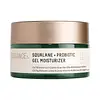What's inside
What's inside
 Key Ingredients
Key Ingredients

 Benefits
Benefits

 Concerns
Concerns

 Ingredients Side-by-side
Ingredients Side-by-side

Water
Skin ConditioningHydroxylated Lanolin
EmollientParaffinum Liquidum
EmollientButyl Stearate
EmollientEthylhexyl Stearate
EmollientPolyglyceryl-2 Sesquiisostearate
EmulsifyingButylene Glycol
HumectantSorbitol
HumectantEthylene/Acrylic Acid Copolymer
Emulsion StabilisingPolybutene
Isodecyl Neopentanoate
EmollientPolyethylene
AbrasiveLanolin Wax
EmollientSqualane
EmollientAscorbyl Palmitate
AntioxidantTocopherol
AntioxidantCeresin
Emulsion StabilisingDimethicone
EmollientGlycol Stearate
EmollientStearamide Amp
Parfum
MaskingDehydroacetic Acid
PreservativeMagnesium Sulfate
Laureth-4
EmulsifyingPEG-20 Beeswax
EmulsifyingPEG-30 Dipolyhydroxystearate
EmulsifyingGlycerin
HumectantSodium Hydroxide
BufferingSilica
AbrasiveSorbic Acid
PreservativePolyaminopropyl Biguanide
PreservativePhenoxyethanol
PreservativeChlorphenesin
AntimicrobialCaramel
Cosmetic ColorantCI 19140
Cosmetic ColorantCI 15985
Cosmetic ColorantWater, Hydroxylated Lanolin, Paraffinum Liquidum, Butyl Stearate, Ethylhexyl Stearate, Polyglyceryl-2 Sesquiisostearate, Butylene Glycol, Sorbitol, Ethylene/Acrylic Acid Copolymer, Polybutene, Isodecyl Neopentanoate, Polyethylene, Lanolin Wax, Squalane, Ascorbyl Palmitate, Tocopherol, Ceresin, Dimethicone, Glycol Stearate, Stearamide Amp, Parfum, Dehydroacetic Acid, Magnesium Sulfate, Laureth-4, PEG-20 Beeswax, PEG-30 Dipolyhydroxystearate, Glycerin, Sodium Hydroxide, Silica, Sorbic Acid, Polyaminopropyl Biguanide, Phenoxyethanol, Chlorphenesin, Caramel, CI 19140, CI 15985
Water
Skin ConditioningGlycerin
HumectantSqualane
EmollientLepidium Sativum Sprout Extract
Skin ConditioningSodium Acrylates Copolymer
Caprylic/Capric Triglyceride
MaskingBisabolol
MaskingPhospholipids
Skin ConditioningHansenula/Kloeckera/Lactobacillus/Lactococcus/Leuconostoc/Pediococcus/Saccharomyces/Fig/Lemon Ferment
Skin ConditioningSodium Hyaluronate
HumectantChondrus Crispus Extract
Skin ConditioningAllantoin
Skin ConditioningGlycine Soja Sterols
EmollientLinoleic Acid
CleansingCapryloyl Glycerin/Sebacic Acid Copolymer
Skin ConditioningDiheptyl Succinate
EmollientCellulose Gum
Emulsion StabilisingLecithin
EmollientSorbitan Oleate
EmulsifyingIsoeicosane
EmollientChitosan
Sodium Phytate
Caprylyl Glycol
EmollientPhenoxyethanol
Preservative1,2-Hexanediol
Skin ConditioningCitric Acid
BufferingWater, Glycerin, Squalane, Lepidium Sativum Sprout Extract, Sodium Acrylates Copolymer, Caprylic/Capric Triglyceride, Bisabolol, Phospholipids, Hansenula/Kloeckera/Lactobacillus/Lactococcus/Leuconostoc/Pediococcus/Saccharomyces/Fig/Lemon Ferment, Sodium Hyaluronate, Chondrus Crispus Extract, Allantoin, Glycine Soja Sterols, Linoleic Acid, Capryloyl Glycerin/Sebacic Acid Copolymer, Diheptyl Succinate, Cellulose Gum, Lecithin, Sorbitan Oleate, Isoeicosane, Chitosan, Sodium Phytate, Caprylyl Glycol, Phenoxyethanol, 1,2-Hexanediol, Citric Acid
 Reviews
Reviews

Ingredients Explained
These ingredients are found in both products.
Ingredients higher up in an ingredient list are typically present in a larger amount.
Glycerin is already naturally found in your skin. It helps moisturize and protect your skin.
A study from 2016 found glycerin to be more effective as a humectant than AHAs and hyaluronic acid.
As a humectant, it helps the skin stay hydrated by pulling moisture to your skin. The low molecular weight of glycerin allows it to pull moisture into the deeper layers of your skin.
Hydrated skin improves your skin barrier; Your skin barrier helps protect against irritants and bacteria.
Glycerin has also been found to have antimicrobial and antiviral properties. Due to these properties, glycerin is often used in wound and burn treatments.
In cosmetics, glycerin is usually derived from plants such as soybean or palm. However, it can also be sourced from animals, such as tallow or animal fat.
This ingredient is organic, colorless, odorless, and non-toxic.
Glycerin is the name for this ingredient in American English. British English uses Glycerol/Glycerine.
Learn more about GlycerinPhenoxyethanol is a preservative that has germicide, antimicrobial, and aromatic properties. Studies show that phenoxyethanol can prevent microbial growth. By itself, it has a scent that is similar to that of a rose.
It's often used in formulations along with Caprylyl Glycol to preserve the shelf life of products.
Squalane is an emollient that helps the skin hold onto moisture. It's an oily liquid that occurs naturally in certain types of fish and plant oils.
Because squalane boosts hydration in the skin, it also comes with plenty of benefits: it is an antioxidant and can help fight free radicals and skin damage. Squalane is also found to have a detoxifying effect when applied.
Squalane comes from squalene, which occurs naturally within the sebum of our skin. It is one of the oils our skin produces to keep itself hydrated. Squalane is the hydrogenated version of squalene and has a longer shelf life.
Research shows that squalane is non-irritating (even at 100% concentration).
In general, it's a fantastic ingredient. It does a great job at hydrating the skin, and it's suitable for those with sensitive skin.
The source of squalane may impact malassezia / fungal acne. This is because olive oil derived squalane can contain impurities such as fatty acids and plant waxes. Sugarcane derived squalane is recommended for anyone with malassezia concerns.
Is squalane vegan?
This depends on the source. Squalane can be derived from both plants and animals. Most squalane used in skincare comes from plants.
Please note: the source of squalane is only known if disclosed by the brand. We recommend reaching out to the brand if you have any questions about their squalane.
Read more about squalene with an "e".
Is squalane an oil?
Squalane is often called an oil, but it’s technically not; it’s a hydrocarbon, meaning it’s only made of carbon and hydrogen, unlike true oils which are triglycerides made of fatty acids and glycerol.
The term “oil-free” isn’t regulated, so companies can define it however they want. Some exclude all oils, while others just avoid mineral oil or comedogenic oils.
While some people avoid oils thinking they cause breakouts, the right kind of oil (or oil-like ingredient like squalane) can actually help balance and hydrate your skin. It’s worth testing out simple oils or squalane to see what works best for your skin.
Learn more about SqualaneWater. It's the most common cosmetic ingredient of all. You'll usually see it at the top of ingredient lists, meaning that it makes up the largest part of the product.
So why is it so popular? Water most often acts as a solvent - this means that it helps dissolve other ingredients into the formulation.
You'll also recognize water as that liquid we all need to stay alive. If you see this, drink a glass of water. Stay hydrated!
Learn more about Water